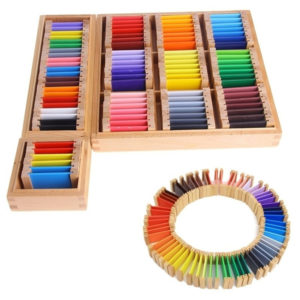Sensorial
The sensorial material helps aid the child’s own natural intelligence through contrasting, discriminating, pairing and grading exercises. This range of material also helps create a real knowledge of shape, size, volume, sound, touch and colour as it exists in the natural world.
In time, these exercises encourage children to become more creative, responsive, appreciative and curious of their own environment, and of others. The inbuilt control of error in the sensorial learning materials allows them to become self teaching through problem solving. Much of this material provides an indirect preparation for writing and a concrete foundation to later maths and geometry.
Knobbed Cylinders
A set of four wooden blocks, each containing ten wooden cylinders varying in height and diameter.
- Development of sensitivity to perception
- To develop visual development of dimension
- Indirectly, prepare for writing by using the pincer grip to hold the cylinder knobs. (Holding a pencil)
- Indirectly, prepare child for later use of math


Pink Tower
A wooden tower consisting of ten pink wooden cubes from 1cm cubed to10cm cubed, in increments of 1cm.
- Visual discrimination of dimension
- Sense of size
- Muscular control of hand and arm
- Education of voluntary movement
- Indirect preparation of mathematical mind
Broad Stairs
Ten wooden prisms increasing in size by 1cm, the largest prism being 10 x 10 x 20cm and the smallest 1 x 1 x 20cm.
- Development of muscular control
- Visual discrimination of breadth or dimension
- Preparation of the mathematical mind


Knobless Cylinders
A set of four coloured wooden cylinders corresponding in height and diameter to the Knobbed Cylinder set.
- To help the child compare different cylinders with each other
- Giving him a clear idea of dimensions and their inter-play
- Preparation for mathematical mind in precision, exactness, logical sequence
Long Stair Red Rods
A set of 10 wooden floor rods varying in increment from 10cm in length from 10cm to 1 metre.
- Discrimination of breath – length
- Development of muscular tactile
- Visual memory
- Indirect preparation for mathematics


Sound Box
12 wooden jars, six with red caps, six with blue caps, contained in two wooden boxes with red and blue lids. The contents of the six jars in one box match the contents in the second box. The child pairs the jars according to sound.
- To aid perfect pitch
- Recognising high and low notes
- Develop the discrimination of sounds which helps the child discriminate between the finer sounds of the letters as an aid to reading
Colour Tablets Box 2
Contains pairs of 11 colours (22 colours).
- Visual discrimination of colour
- Development of the chromatic sense
- Provide the child with the keys to the world of colour
- Preparation for later art work of mixing colours

